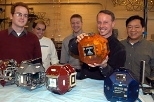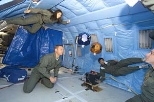Three MIT satellites resembling brightly colored volleyballs await a trip to the International Space Station in the next step of a research project begun by undergraduates that could lead to better space telescopes, robotic "repairmen" for space-based equipment, and much more.
They are slated to fly to the ISS May 19 on the Russian Progress-14P launch. The hardware was shipped to Baikonur launch area earlier this month.
The satellites are essentially a lab for "developing techniques to allow future satellites to cooperate with each other," said David W. Miller, an associate professor in the Department of Aeronautics and Astronautics and director of the Space Systems Laboratory.
Imagine, for example, satellites that could rendezvous in space to build larger systems, or repair and resupply other satellites. "Right now, if a big expensive satellite runs out of fuel or a circuit board blows, it's abandoned," Miller said. Satellites that fly in formation are also key to future space telescopes. Several tiny satellites outfitted with mirrors and strung across the sky could create a telescope with a higher resolution than the Hubble.
Recently the MIT team and its research partner, Payload Systems Inc. of Cambridge, won a NASA contract related to getting soil samples from Mars back to Earth. Essentially small, smart satellites equipped with "catcher's mitt" mechanisms would capture Mars sample capsules launched into space by rovers on the planet's surface.
There are other research projects involving satellite formation flight underway at places like Stanford and NASA's Goddard Space Flight Center. The MIT SPHERES project--for Synchronized Position Hold Engage Re-orient Experimental Satellites--was designed to complement that work and is the first satellite-formation project to be tested aboard the ISS.
SPHERES began in 1998 as an educational experiment through MIT's Department of Aeronautics and Astronautics. The idea was to give undergraduates the opportunity to design, implement, and test an aerospace product within one course (conducted over three semesters).
The team of 13 students met the challenge. Working with Miller, Associate Professor Dava J. Newman, and Payload Systems, the students ultimately tested two prototype SPHERES in 2000 aboard NASA's KC-135 airplane. The KC-135 allows satellites (and researchers) to become essentially weightless for short periods of time, an environment that more closely approximates conditions in space.
After the original students graduated--one, Stephanie Chen (S.B. 2000), is employed by Payload Systems--Miller and colleagues from MIT and Payload Systems took the project to the next level, building SPHERES that meet the stringent requirements for a trip into space. "We modified the design," Miller said, "but it still draws heavily from the students' original work."
The current team includes Miller, research scientist Edmund Kong, and graduate students Alvar Saenz Otero, Simon Nolet, Dustin Berkovitz, Mark Hilstad and Arthur Richards. Last month the team tested the modified satellites aboard the KC-135.
The new SPHERES will communicate with each other over wireless links and determine their positions inside the ISS via five beacons mounted on the spaceship's walls that provide the equivalent of a GPS navigation capability. "It's basically how the SPHERES figure out where they are," Miller said. The satellites will move around via small propellant tanks that, when depleted, can be easily popped out and replaced by the astronauts.
Miller stressed the value of testing the SPHERES aboard the ISS. For one, even the most careful ground-based tests are not necessarily representative of conditions in space. And the periods of microgravity available in the KC-135 are too short for more involved experiments.
Also, "the crew is instrumental to giving us feedback on what's going well and what isn't." If something does go awry, "within 72 hours I can get data and video, fix the algorithms, send them up and try again," said Miller.
As the researchers wait for the May liftoff to the ISS, they continue to work on future SPHERES. For example, they are developing Exo-SPHERES to fly outside the space station, and exploring a propulsion system that doesn't require changing used tanks.
DARPA, NASA's Goddard Space Flight Center and NASA's Jet Propulsion Laboratory sponsor the work.
A version of this article appeared in MIT Tech Talk on March 31, 2004.







